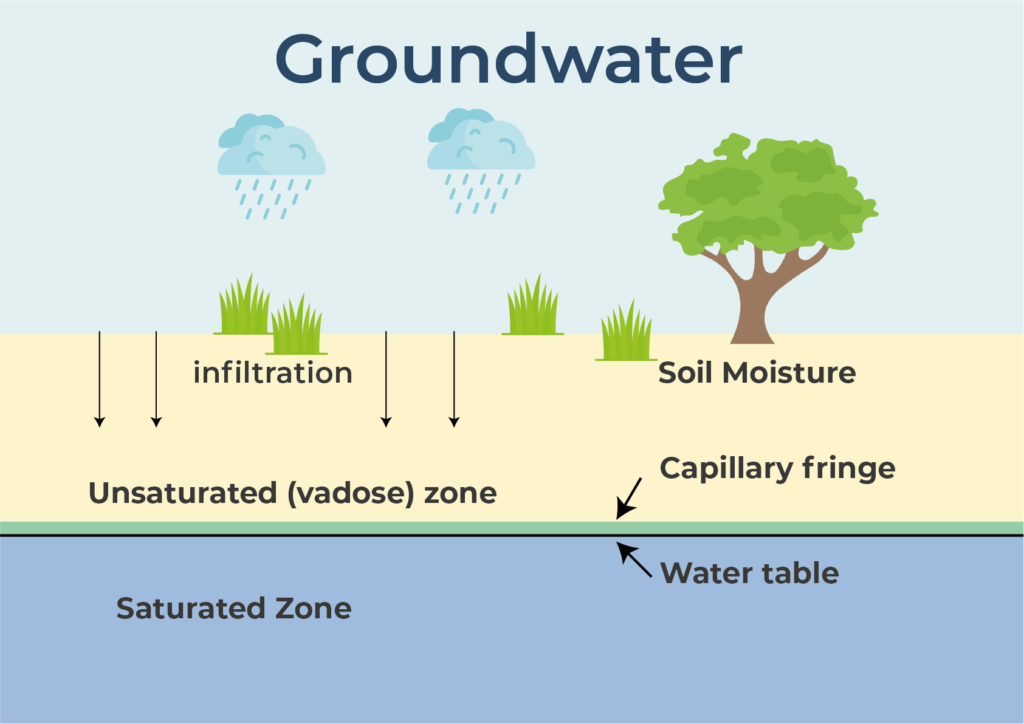What Does
Groundwater Table Mean?
The groundwater table, as the name suggests, is the upper limit or surface of groundwater. Water occupies the area beneath the water table, which is the saturated zone. It saturates the medium (soil, rocks) through which it passes and in which it is stored.
The groundwater table rises or falls depending on factors such as rainfall, absorption by plants, human activity, and topography. A permeable medium will also allow water to flow through assisted by gravity and pressure difference.
The groundwater table separates saturated ground below from aerated ground above. When digging through aerated soil, water ingress into the construction is not an issue, but this is not true below the groundwater table.
Carrying out trenchless construction or rehabilitation projects beneath the groundwater table requires adequate steps to prevent water from entering the pipe under construction or repair. When establishing an entrance or exit pit using shoring below the groundwater table, it is necessary to use a sealed shoring design to prevent water from building up in the pit.
Groundwater can also infiltrate or find its way into the underground water and sewerage system. Small leaks, openings, defective joints, and cracks are the main causes of infiltration and are unavoidable to a certain extent. However, to prevent the overloading of treatment plants, it is preferable to control it, especially where combined sewer systems are still in use. In areas that experience wet and rainy seasons, the weather can contribute to flooding issues.
Trenchless inspection using closed-circuit television (CCTV) camera can find problem spots causing infiltration. They are easily repaired using trenchless rehabilitation methods such as cured-in-place pipe, sliplining, and pipe bursting.
Trenchlesspedia Explains Groundwater Table
Hydrogeology, the study of groundwater, helps understand how groundwater enters and flows through the earth’s subsurface and its interaction with the surrounding soil and rock. It also helps us to understand the means by which it recharges, the paths it takes, the chemical composition, and the quality of the groundwater.
The groundwater level is an important parameter that influences the behavior of soil in drained and undrained conditions, so is an important factor in the design of sub-surface pipelines.

The groundwater level changes significantly depending on natural factors such as floods and droughts. Human activity like dewatering and construction projects can also affect groundwater levels. The study of these changes over a certain time period can gather enough data to help assess the current state of the groundwater in a particular area. Once that data is collected, laboratory testing of soil samples is conducted to determine the feasibility of construction projects such as trenchless pipeline installation.
What is Groundwater?
All water below the sub-surface is not groundwater, though groundwater is sub-surface water. The area below the water table including pore spaces and cracks in rocks and sediments is completely saturated with water. The water in this saturated zone is where groundwater occurs. In the layers of soil above the water table or the unsaturated zone, water does not completely fill the pore spaces. This is the vadose zone or the zone of aeration as some of the pore spaces contain air.
During heavy rainfall, this unsaturated zone can be completely saturated, while during a dry spell it may become completely dry. The water from rainfall will precipitate down through the unsaturated zone, and when this precipitating water is at a level where plant roots can easily utilize it, it is soil water. When the infiltrating water goes below the root level, it is vadose water. Continued infiltration eventually leads it to the water table. The water table rises with an increase in recharge from precipitation and declines during dry weather, drought, or excessive pumping.